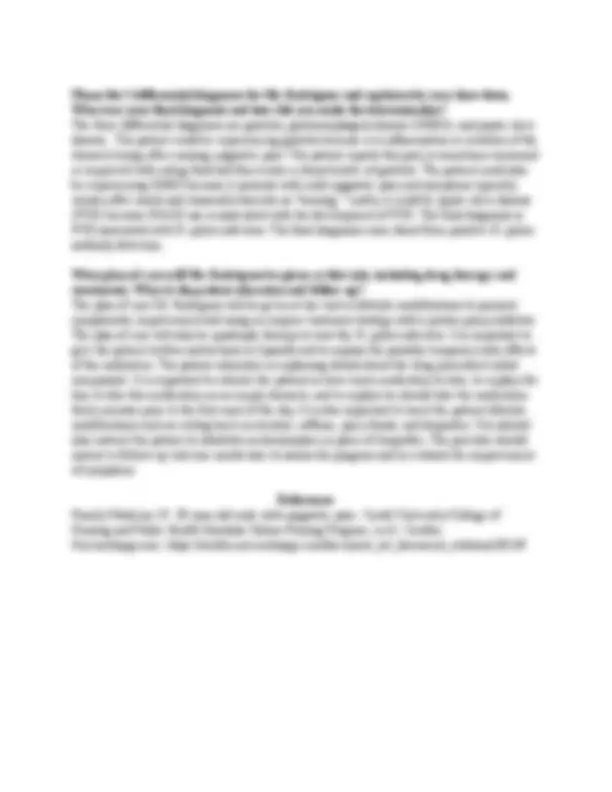



Study with the several resources on Docsity

Earn points by helping other students or get them with a premium plan


Prepare for your exams
Study with the several resources on Docsity

Earn points to download
Earn points by helping other students or get them with a premium plan
Community
Ask the community for help and clear up your study doubts
Discover the best universities in your country according to Docsity users
Free resources
Download our free guides on studying techniques, anxiety management strategies, and thesis advice from Docsity tutors
Family Medicine 19: 39-year-old male with epigastric pain Mr. Rodriquez's case study answers in addition to finances, what are the common reasons for immigrants to avoid seeking medical care? select all that apply Discuss Mr. Rodriquez’s history that would be pertinent to his gastrointestinal problem. Include chief complaint, HPI, Social, Family, and Past medical history that would be important to know. Describe the physical exam and diagnostic tools to be used for Mr. Rodriguez. Are there any additional you would have liked to be included that were not? Please list 3 differential diagnoses for Mr. Rodriguez and explain why you chose them. What was your final diagnosis and how did you make the determination? What plan of care will Mr. Rodriquez be given at this visit, including drug therapy and treatments; What is the patient education and follow-up?
Typology: Quizzes
1 / 2

This page cannot be seen from the preview
Don't miss anything!


Family Medicine 19: 39-year-old male with epigastric pain The ideal summary statement concisely highlights the most pertinent features without omitting any significant points. The summary statement above includes: Epidemiology and risk factors: 39-year-old previously well Latino immigrant. Key clinical findings about the present illness using qualifying adjectives and descriptive language: Chronic progressively worsening No vomiting, hematemesis, hematochezia, melena, or association with meals Quit smoking Occasional alcohol consumption Uses NSAIDs Uses traditional herbal teas Week 3 Gastrointestinal Discussion Discuss Mr. Rodriquez’s history that would be pertinent to his gastrointestinal problem. Include chief complaint, HPI, Social, Family, and Past medical history that would be important to know. Mr. Rodriguez’s chief complaint is abdominal pain. His history of present illness is abdominal pain that began a year ago and the abdominal pain occurred a few times a week, but now hurts every day. The patient reports burning in his epigastric area. His social history includes that he works as a farm laborer and reports a history of smoking cigarettes, drinking 3-4 beers a week, and denies drug use. Mr. Rodriguez reports that he quit smoking 6 months ago and says he has not traveled recently. The patient is a Latina immigrant who takes NSAIDs frequently and consumes herbal teas occasionally. The patient reports a family history of his father having hypertension and his mother having diabetes. The patient denies any medical problem except the existing stomach pain. The patient reports no known allergies. Describe the physical exam and diagnostic tools to be used for Mr. Rodriguez. Are there any additional you would have liked to be included that were not? The physical exam used for Mr. Rodriguez is a head-to-toe assessment. The provider also did a focused assessment of the abdomen. The diagnostic tool that was used was a basic review of symptoms and an assessment. The diagnostic test performed to diagnose the patient is an H. pylori fecal antigen test, H. pylori serology, urease breath test, and a fecal occult blood test. I believe it would be important for the patient to use a food diary to determine what foods cause improvement or worsening symptoms to see if modifying the patient’s lifestyle will bring about positive results. It would also be helpful to refer the patient for an upper endoscopy to rule out other significant GI diseases.
Please list 3 differential diagnoses for Mr. Rodriguez and explain why you chose them. What was your final diagnosis and how did you make the determination? The three differential diagnoses are gastritis, gastroesophageal disease (GERD), and peptic ulcer disease. The patient could be experiencing gastritis because it is inflammation or irritation of the stomach lining often causing epigastric pain. The patient reports this pain is sometimes worsened or improved with eating food and this is also a characteristic of gastritis. The patient could also be experiencing GERD because it presents with mild epigastric pain and symptoms typically worsen after meals and classically describe as “burning.” Lastly, it could be peptic ulcer disease (PUD) because NSAID use is associated with the development of PUD. The final diagnosis is PUD associated with H. pylori infection. The final diagnosis came about from positive H. pylori antibody detection. What plan of care will Mr. Rodriquez be given at this visit, including drug therapy and treatments; What is the patient education and follow-up? The plan of care Mr. Rodriguez will be given at his visit is lifestyle modifications to promote symptomatic improvement and using an empiric treatment strategy with a proton pump inhibitor. The plan of care will also be quadruple therapy to treat the H. pylori infection. It is important to give the patient written instructions in Spanish and to explain the possible temporary side effects of the antibiotics. The patient education is explaining details about the drug prescribed called omeprazole. It is important to educate the patient on how much medication to take, to explain for him to take this medication on an empty stomach, and to explain he should take the medication thirty minutes prior to the first meal of the day. It is also important to teach the patient lifestyle modifications such as cutting back on alcohol, caffeine, spicy foods, and ibuprofen. You should also instruct the patient to substitute acetaminophen in place of ibuprofen. The provider should instruct a follow-up visit one month later to assess the progress and to evaluate for improvement of symptoms. References Family Medicine 19: 39-year-old male with epigastric pain - South University College of Nursing and Public Health Graduate Online Nursing Program. (n.d.). Southu- Nur.meduapp.com. https://southu-nur.meduapp.com/document_set_document_relations/